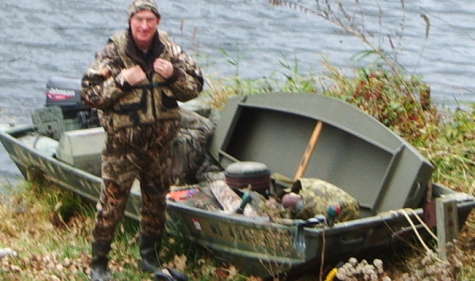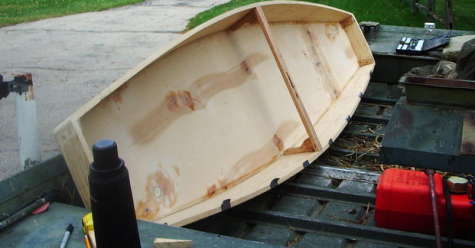Constructed and launched autumn, 2009, Brice Prairie, Wisconsin (Click photos to enlarge)
This design is for a small, protected-water "skiff", hopefully with some of the performance of the Upper Mississippi River Duck Skiff, but which is small enough and specifically designed to nest inside a flatboat "Mothership" for transport out into the marshes through open water. A skiff like this is used to move into extreme shallows where a larger boat cannot navigate or be easily concealed, for putting out decoys, and for retrieving downed birds. On occasion, it might be used to jump-shoot, paddling small streams and marsh edges, particularly for wood ducks early in the year.
I used to tow these things, but have had WAY too many hairy experiences towing them in storms. This nesting idea is much safer.
Here's the skiff nested in its mothership (before building the cradle to carry it more vertically):

Note the lack of a center thwart in the flatboat, which makes this nesting idea workable. The cockpit of the skiff is usable storage while underway in the mothership - you can pile decoys and other gear in it - not wasted space!
The boat was designed in Robert Laine's "Carene 2008" software, which I find great to play around with design ideas easily. Here's a screenshot of the design in Carene:

Carene 2008 hull data file used to make this plot: NestedSkiff_8_29straightop_80.D50
Design Constraints
- Freeboard = double immersed draft amidships, but as low as possible for visibility to ducks (Probably could use 7", but went with 8" to be safe. Will add taller coaming if it turns out to be a submarine)
- Side Flare = bow and stern transom flare, chose 10* (Along with bottom rocker, helps skiff to nest in alongside the flatboat sides)
- Fits inside flatboat bow-to-seat, wedged in by bow and stern transoms (~3+ meters)
- Transom width = Half of Max Beam
- Flat (no camber) decks fore & aft (for quick building)
- Rocker to allow bow/stern and chins not quite immersed with hunter and decoys
A 29-inch beam (at the bottom) made the displacement come out about right, and I felt that would be about right for stability (it was). Did not want more beam than needed, to keep weight down, and so it would not stick up too high when carried on its side in the mothership.
Here was the idea of how it was to nest (upper purple line is flatboat gunwale, next two are skiff keel and bottom, dark green is flatboat chine):

The skiff's side curvature is close to the flatboat's bottom rocker up forward, and it does nest between the seats of the flatboat (again, note the lack of a center seat in this flatboat, and no deck yet on skiff):

......and the bottom rocker picks up some of the curve of the flatboat gunwale to fit better (pic taken before keel added, which is also rockered, and handily keeps the skiff bottom from rubbing on the oarlock):

The original idea was to match the flare of the skiff exactly to the flare of the flatboat, but I thought flatboat flare (varies from 32 degrees aft to 22.5 degrees forward was just too extreme for a practical skiff.
The skiff is built "instant boat style", ala Bolger/Payson, using the developed panels projected by Carene 2008. There is one frame, centered in this symmetrical boat.
The identical bow/stern transoms projected by Carene 2008 help to give it shape while under construction. Transom measurements are to outside edges and bevels depart from the outermost edges - that is how Carene figures things, with no thickness:
- 13" (bottom) by 14" (top)
- Side Bevel: 80 degrees
- Bottom Bevel 74 degrees
- Top Bevel 83 degrees
- Height, about 4 1/8"
- Leave top a little high and plane down after flipping boat
These boats are paddled kneeling, for ease of shooting (much harder to shoot from a sitting position). Also there is LOTS of getting in and out in this kind of work, going over beaver dams and shallow spots. You wedge in between the coaming with your thighs for stability, and against the thwart.
A short, rockered boat like this will just go round in circles with a single paddle, unless you give it ample keel, which I did, clear out to the ends (you can see it poking out here ). The full-ish keel adds to the odd look of the boat, but it works nicely. I may actually plane a little off the ends - it has plenty. Double (kayak) paddles are NOT for this type of boat: The wagging of the high paddle blade in the air will scare ducks for miles around, they are hard to store in a short boat, and do not work as well when using the paddle to pole over mud, which we do a LOT. I built a special thick-bladed paddle for this work, thick and flat on the bottom, which does not sink down in mud and stick there like a conventional thin paddle.
It was a real pleasure to discover this little boat handled just as I had hoped. She paddles straight, carries her load just right, is not too tippy, and really is just fun to paddle. :)
Construction: details and photos
Finished Boat: Photo Gallery
Next steps to trick it out a little further"
- need to find a source of black UHMW strips for the keel shoe and gunwale rub strips
- stability poles (with stilt step), so it can be entered/exited in waist-deep water - they can lock/ratchet onto the gunwale rubstrips
- a short spare/emergency paddle
